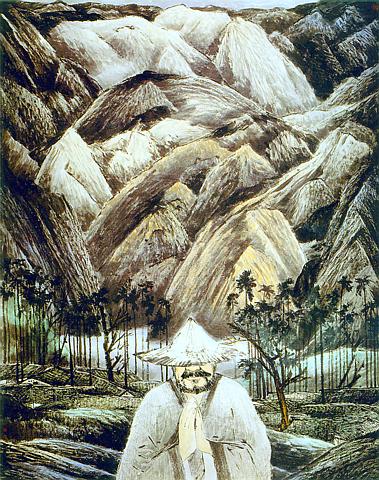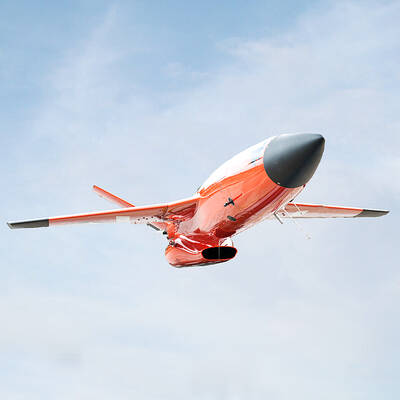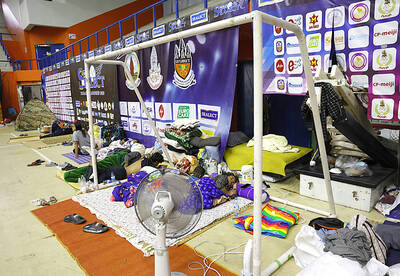After a single glance at Lee Yi-hong's scroll paintings, one knows he is a Chinese painter of the old school. His towering cliffs, rolling waves and miniature humans clearly identify his genre as shuimo (landscapes). After a second glance, doubts arise however. Indeed, the longer one looks at the works in Lee's latest exhibition `Infinite Cosmos -- Infinite Buddhism,' the more modern they seem. One might even wonder whether they were painted by a Chinese artist.
Lee is Chinese; he was born in Tainan in 1941 and graduated from the National Academy of Arts in 1966.
"Like all artists of my generation I undertook a thorough study of classical Chinese painting, first at the academy and later as a student of the famous painter and calligrapher Chiang Chao-shen. Chiang was himself a student of the last Ching Emperor's uncle." As Lee talks about his life and work, his conversation is peppered with quotes from Tang and Sung dynasty shuimo artists. Asked to place his art in historical context however, he replies without hesitation, "Absolutely modern."

PHOTOS: COURTESY OF LEE YI-HONG
"The brushstrokes I used for `Quiet Meditation' are much broader than those found in classical works, whilst in Arhats amongst the Pines, I wanted to experiment with covering every inch of the paper. Shuimo makes great use of unpainted spaces. Space on the canvas but feeling in the stomach."
Lee makes little use of the symbolic language found throughout Chinese painting. Pines, trees that resist the cold and do not shed their needles, symbolize longevity, steadfastness and self-discipline. Bodhi trees, like those in Lee's `Bodhi Path,' represent the road to enlightenment. Caves, like Juewang Cave, Lion Mountain, are a habitual haunt of good-natured spirits and hermits.
Wandering around his own exhibition at the Lungshan Gallery, the artist points out many of his favorite locations around Taiwan. In addition to Mt. Lion, Lee identifies numerous seemingly abstract scenes: a tree in the grounds of a local monastery or a cliff on the coast road south of Su-ao.

Cliffs figure prominently in this series, their majesty and permanence contrasting sharply with the almost insignificant human figures meditating beneath. Buddhism teaches that all earthly phenomena are impermanent however, and cautions against "clinging to the unreal as real." This was never clearer than during the 921 earthquake, which, after depriving Lee of his creative impulses for several weeks, became a new source of inspiration.
"I didn't want to paint rent earth and shattered lives though, I could capture those with my camera," says Lee, whose photography has also won numerous awards. His main post-earthquake work, `Compassionate Peak,' is intentionally ambiguous, perhaps depicting a farmer, perhaps a monk. Lee is interested to see if the raised levels of religious compassion and communal cohesion observed since the disaster will be long-term additions to Taiwan's social climate that had been lurching towards unfettered materialism.
"Chinese art, like Chinese Mahayana Buddhism, is more usually interested in Bodhisattvas, particularly the Bodhisattva Guanyin. Guanyin took a vow of compassion and abandoned her own pursuit of enlightenment and salvation to assist in `ferrying the myriad living beings across the sea of suffering to the other shore of Nirvana.' I chose to paint arhats because they are at an earlier stage of spiritual cultivation, and therefore much nearer to us."

Lee admits that whilst he might think of himself as a Buddhist, he still eats meat and does not meditate. "Actually, I know very little about Buddhism or any religion. ... I just liked the feeling of peace that the arhats brought to my pictures. I never really planned to put them in there."
The artist then explains that, of the two methods of executing shuimo paintings, either with meticulous planning or through "an instantaneous outpouring of emotion from one's stomach," he favors the latter.
"I never alter a piece. If I like it, I select a chop and a pad of red ink and affix my name. If I don't, it goes in the bin." Chinese paintings which do include arhats generally concern the sixteen who were personal disciples of the Sakyamuni Buddha. They are painted with well-established distinguishing characteristics such as Pindola with his bushy eyebrows or the Tiger-Subduing Arhat. Lee's arhats are cartoons in comparison and represent his own emotions more than any classical form or religious ideal. Similarly, the texts accompanying many of his works are as likely to be his own observations as quotations from Buddhist canons.
These texts help to draw the viewer up close to the painting, a technique often used in shuimo to enable the work to be considered from a variety of angles and distances. This is definitely applicable to Lee's current work. However long one looks and from however many angles, one comes away with the feeling of having merely experienced a fraction of what the painting has to offer.
Summing up his approach to art, Lee Yi-hong says, "Instead of using abstract expressions to discuss real phenomena, I try to use concrete expressions to discuss abstract concepts."
For your information
Lee's solo exhibition is on display at the Lungmen Art Gallery, 2F, No.2, Lane 150, Sec.5, Hsinyi Rd., Taipei, until Jan.15. Paintings are priced from NT$200,000 to $1,200,000.

‘WIN-WIN’: The Philippines, and central and eastern European countries are important potential drone cooperation partners, Minister of Foreign Affairs Lin Chia-lung said Minister of Foreign Affairs Lin Chia-lung (林佳龍) in an interview published yesterday confirmed that there are joint ventures between Taiwan and Poland in the drone industry. Lin made the remark in an exclusive interview with the Chinese-language Liberty Times (the Taipei Times’ sister paper). The government-backed Taiwan Excellence Drone International Business Opportunities Alliance and the Polish Chamber of Unmanned Systems on Wednesday last week signed a memorandum of understanding in Poland to develop a “non-China” supply chain for drones and work together on key technologies. Asked if Taiwan prioritized Poland among central and eastern European countries in drone collaboration, Lin

The Chien Feng IV (勁蜂, Mighty Hornet) loitering munition is on track to enter flight tests next month in connection with potential adoption by Taiwanese and US armed forces, a government source said yesterday. The kamikaze drone, which boasts a range of 1,000km, debuted at the Taipei Aerospace and Defense Technology Exhibition in September, the official said on condition of anonymity. The Chungshan Institute of Science and Technology and US-based Kratos Defense jointly developed the platform by leveraging the engine and airframe of the latter’s MQM-178 Firejet target drone, they said. The uncrewed aerial vehicle is designed to utilize an artificial intelligence computer

The US government has signed defense cooperation agreements with Japan and the Philippines to boost the deterrence capabilities of countries in the first island chain, a report by the National Security Bureau (NSB) showed. The main countries on the first island chain include the two nations and Taiwan. The bureau is to present the report at a meeting of the legislature’s Foreign Affairs and National Defense Committee tomorrow. The US military has deployed Typhon missile systems to Japan’s Yamaguchi Prefecture and Zambales province in the Philippines during their joint military exercises. It has also installed NMESIS anti-ship systems in Japan’s Okinawa

Renewed border fighting between Thailand and Cambodia showed no signs of abating yesterday, leaving hundreds of thousands of displaced people in both countries living in strained conditions as more flooded into temporary shelters. Reporters on the Thai side of the border heard sounds of outgoing, indirect fire yesterday. About 400,000 people have been evacuated from affected areas in Thailand and about 700 schools closed while fighting was ongoing in four border provinces, said Thai Rear Admiral Surasant Kongsiri, a spokesman for the military. Cambodia evacuated more than 127,000 villagers and closed hundreds of schools, the Thai Ministry of Defense said. Thailand’s military announced that